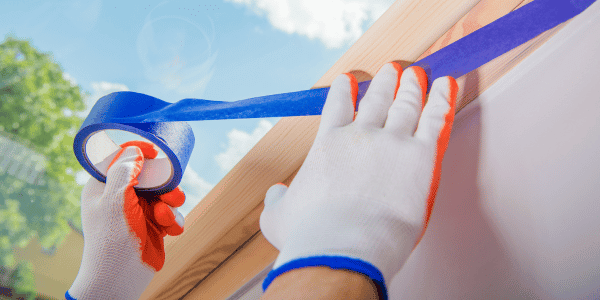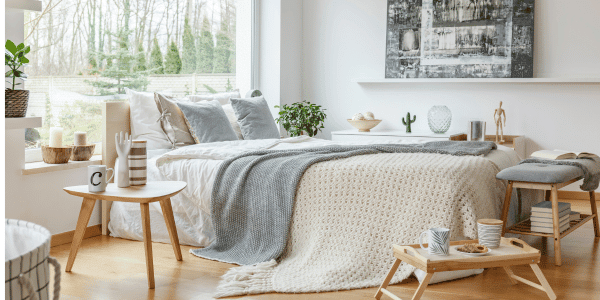6 Great Home Painting Tips For Beginners
There’s nothing like the way a room looks after a fresh coat of paint. One of the most novice-friendly DIY tasks out there, home painting can boost your home’s appearance and make it seem cleaner and more modern. However, not every paint project turns out the same; common pitfalls are to blame—but they can be avoided. By learning what not to do, achieving a picture-perfect paint job is possible. Learn how to paint a room with six of the best house painting tips for beginners.
6 House Painting Tips for Beginners
1. Safeguard edges.
The biggest sign of a below-average home painting job is the occasional spot of paint on the trim or ceiling. These errors can easily happen when you don’t create boundaries. Pros have safeguards against painting “outside the lines,” which means you should, too.
How to Paint Edges
- Line edges with painter's tape or use a spray painting shield.
- Press down on your painter’s tape as you go to create a tight seal and reduce the risk of paint bleed-through.
- Guarantee your spray paint shield is properly secured to prevent it from slipping or sliding in the middle of a paint job.
- Take your time. It will save you hours of backtracking and corrective spot-painting in the long run.

2. Never paint over glossy paint or varnish.
Contrary to popular belief, the paint color you choose isn’t the only thing that’ll influence your results—the texture of the surface you want to paint matters as well. While your existing glossy paint may be excellent at repelling scuffs, it’s also going to repel a new coat of paint and look streaky. Luckily, there’s a quick fix when learning how to paint a room. Before you start painting over any glossy surface, sand it or wipe it down with a liquid deglosser, also known as liquid sandpaper. It’s an extra step, but worth it.
Not sure what color paint to use? Check out these mood-boosting paint colors for every room.
3. Don't work in dim or low light.
It’s important to approach your home improvement project with eyes wide open—which means you need to see everything clearly. A great interior painting tip: don’t try to paint at night or on a dreary afternoon when the lighting is low; you won’t get an accurate picture of how well your paint is covering up the old color. Take your paint project outside on a sunny day or start an inside job in the morning when there’s plenty of natural light streaming in. With good lighting, the thin areas that need another roll or two will be obvious right away.
4. Move quickly.
An unsightly error, overlapping brush marks are more evident with darker paint colors and higher glosses. The key to avoiding this is to keep a “wet edge."
Wet Edge Painting Tips
- Quickly move between sections so the paint doesn’t dry along the edge and prevent a seamless blend.
- Don't paint in just one direction.
- Gently and swiftly overlap layers to produce a solid color block instead of separate paint streaks.
5. Add paint conditioner for detailed areas.
While paint from the can is thick enough to cover walls, it’s too thick for areas that need to express finer details, like woodwork, doors, cabinets, and textured molding. Paint conditioner thins out your paint slightly so you can apply coats delicately without appearing thick and gloppy. When doing your painting prep steps, mix a small amount of the conditioner with the can of paint to get your desired consistency, and always read the directions for the best results.
6. Use primer, especially on dark walls.
If you want to cover up a bold or dark color with a light one, follow these wall painting tips:
First, you must apply primer first to “soften up” the previous color. Directly using light paint over a dark wall will force you to apply additional layers, and you may not even cover up the dark color completely. However, using a primer as your first coat will cut your work in half and create a surface that adheres to paint efficiently. Just make sure your primer has dried according to the manufacturer’s directions before painting over it, so you don’t get yourself into another painting mess.
How to Use Primer Paint
- Prepare your wall. Remove any outlet covers, nails, or lightswitch plates and wipe your walls clean.
- Protect your surfaces. Cover anything that you don't want painted so it's not affected.
- Dampen your brush or roller. This will make your primer easier to absorb and apply.
- Spot primer corners and edges. You don't want your roller or brush to hit the wrong spots.
- Apply primer and sand. Tackle your walls in small sections with your brush or roller. After it dries, sand away bumps and ridges.
BONUS: More Painting Tips from the Pros
Still need some guidance? Here are more of our favorite painting tips and tricks:
WHAT TO DO BEFORE PAINTING
- Cover all floors and furniture with a drop cloth and remove switch plates
- Clean your walls and baseboards with lukewarm water and mild soap
- Ensure pets are unable to access the painting area
WHAT TO DO WHILE PAINTING
- Avoid working in extreme temperatures (between 50-90 degrees Fahrenheit is ideal)
- Paint walls top to bottom
- Don't dunk your brush in all the way--just cover one-third of the bristles
- For inside paint jobs, open windows to release fumes
WHAT TO DO AFTER PAINTING
- Wait 24 hours before applying a second coat
- Store cans in a cool, dry area to maintain color and quality
- Buy extra paint for future touch-ups

Beginner Painting Ideas
Your first home painting project doesn't have to be big. Before you go for the bedrooms or a full-on repainting, start small and test what you've learned on spaces like your:
- Bathroom
- Storage room
- Laundry room
- Closets
- Doors
Should You Leave Your Painting Project to the Pros?
Thanks to apps like Pinterest, YouTube, and TikTok, painting tips for beginners are readily available, and the DIY home painting craze is here to stay. It’s simple to find instructional videos on how to do everything from do-it-yourself painting tips to toilet installations and deck replacements. But, before painting your house, think it through. Read our article, “When to DIY vs. When to Hire a Pro,” for signs that it’s safe to take on your home reno task alone and others that signal a pro might be better for the job.
Home Painting FAQs
Is it worth painting your own house?
Painting your house yourself could be a good idea. It all comes down to whether you have the right tools, know the proper techniques, and are willing to put in the time and effort to complete a successful job.
What is the correct way to paint a house?
When painting your home's exterior, you should work from the bottom to the top with smooth and controlled strokes. When painting home interiors, you should also start at the top with your ceiling, then work down to your walls, baseboards, window seals, and doors.
Is it easy to paint your own house yourself?
While painting your own house will take a lot of labor, the process will not be difficult if you take the time to understand proper tools and techniques before you get started.
Do I need primer before painting?
Yes, you should always use primer before you paint to protect the materials under your home's walls.
How much does it cost to paint a whole house?
Painting an entire home can cost anywhere from a few thousand dollars to over $20,000, depending on the size of the home, the complexity of its structure, and the quality of the paint, tools, and techniques being used.